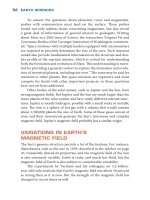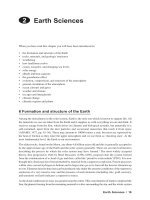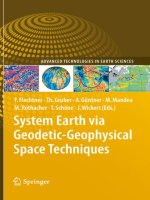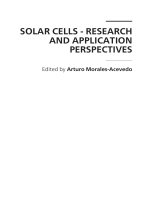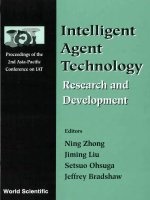EARTH SCIENCES - Notable Research and Discoveries
Bạn đang xem bản rút gọn của tài liệu. Xem và tải ngay bản đầy đủ của tài liệu tại đây (1.8 MB, 24 trang )
earth ScienceS
52
To answer the questions about planetary cores and magnetism,
probes with seismometers must land on the surface. ese probes
would not only address issues concerning magnetism, but also reveal
a great deal of information of general interest to geologists. Writing
about Mars in a 2005 issue of Science, the researchers Yingwei Fei and
Constance Bertka of the Carnegie Institution of Washington comment-
ed, “Space missions with multiple landers equipped with seismometers
are required to precisely determine the size of the core. Such missions
would also provide fundamental information on the structure and den-
sity prole of the martian interior, which is critical for understanding
both the formation and evolution of Mars. is understanding is essen-
tial for providing a general context to explore the formation and evolu-
tion of terrestrial planets, including our own.” e same may be said for
missions to other planets. But space missions are expensive and must
compete for funds with other important projects, so these questions
have not yet been addressed.
Other bodies of the solar system, such as Jupiter and the Sun, have
strong magnetic elds. But Jupiter and the Sun are much larger than the
inner planets of the solar system and
have vastly dierent
internal struc
-
tures. Jupiter is mostly hydrogen, possibly with a small rocky or metallic
core. e Sun is a sphere of hot gas with a volume that would contain
about 1,300,000 planets the size of Earth. Some of these gases consist of
ions, and their movements generate the Sun’s enormous and complex
magnetic eld. Jupiter’s magnetic eld probably has a similar origin.
VaRIatIonS In EaRtH’S
MaGnEtIC FIEld
e Sun’s gaseous structure permits a lot of uctuations. For instance,
disturbances such as the one in 1859, described in the sidebar on page
45, transiently altered its properties, and the magnetic eld of the Sun
is also extremely variable. Earth is rocky and much less uid, but the
magnetic eld of Earth is also subject to considerable variability.
e experiments by Tarduno and his colleagues on 3.2-billion-
year-old rocks indicate that Earth’s magnetic eld was about 50 percent
as strong then as it is now. But the strength of the magnetic eld has
changed in recent times as well.
FOS_Earth Science_DC.indd 52 2/8/10 10:57:36 AM
53
Measurements of magnetic elds rely on the interactions of these
elds with other magnets, ferromagnetic materials, or electric charges.
Iron lings orient themselves along the lines of force that a magnetic
eld exerts, for example, as does a compass needle exposed to Earth’s
magnetic eld. A magnetometer provides more information by measur
-
ing the strength and direction of a magnetic eld. e German math-
ematician and scientist Carl Friedrich Gauss (1777–1855) published
the earliest description of a magnetometer in 1833; the instrument was
simple, consisting of a bar magnet suspended by a gold ber, and indi
-
cated magnetic eld strength by the period of its oscillation. (Magnetic
elds aect the time, or period, of a magnet’s back and forth motion.)
One of the standard units of magnetic eld force or intensity is named
aer Gauss to honor his achievements.
Instruments such as SQUIDs are much more sensitive than Gauss’s
simple magnetometer, and many other types of magnetometer have
been developed. But any use of magnetometers to measure Earth’s
magnetic eld must take into account possible contributions by “stray”
magnetic elds. Sources for these elds include currents owing in elec
-
trical equipment and especially the large amount of current owing in
the overhead
or underground wires of the power companies. Even iron
that is not magnetized may have small, disorganized magnetic elds
due to partial alignment of domains. (is feature of iron troubled a lot
of navigators and sailors in the 19th century as shipbuilders switched
from wood to steel, which is mostly iron—stray magnetic elds in the
ship’s steel disrupt the compass unless the instrument is adequately
shielded.)
Despite the diculties, records of careful measurements date back
to the 1840s, when sailors and scientists began charting Earth’s magnet
-
ic eld strength. ese measurements continue today at stations such
as Hartland Magnetic Observatory, operated by the British Geological
Survey (BGS) and located in a large meadow in southwestern England
near the village of Hartland in the county of Devon. By comparing past
records with present measurements, geologists have found a decline of
roughly 10 percent in Earth’s magnetic eld strength in the last century
and a half.
Analysis of rocks lets scientists explore the history of Earth’s mag
-
netic eld even further back in time. Paleomagnetism refers to the pres-
ervation or record of Earth’s magnetic eld in the structure of rocks and
Origin and Variability of Earth’s Magnetic Field
FOS_Earth Science_DC.indd 53 2/8/10 10:57:37 AM
earth ScienceS
54
other geological formations. Studies such as that of Tarduno and his
colleagues reach back billions of years.
One of the most important branches of paleomagnetism involves
the study of iron-bearing igneous rocks, which are formed by the cool
-
ing and solidication of molten rock. Lava eruptions, for example, cool
and harden over time. e presence, strength, and direction of Earth’s
magnetic eld at the time these rocks solidify has a powerful inuence
on the orientation of the particles of iron; while the rock is molten, the
iron and iron minerals orient to the eld, and become xed in place
as the rock crystallizes. Contained within these rocks is a sketchy but
informative history of Earth’s magnetic eld.
e most startling nding of paleomagnetism comes from studies
of the seaoor. In the 1940s during World War II, military engineers
from the United States and other countries developed magnetometers
to scan for submarines. ese magnetometers, towed by ships, detect
-
ed magnetic elds associated with the steel hulls of submarines. Aer
the war, geologists modied this equipment to study the ocean oor
and were surprised to discover regular variations in magnetic elds as
they sailed back and forth across the ocean, particularly the
middle of
the
Atlantic Ocean. ese eld uctuations were natural phenomena,
although anomalous—unexpected and unexplained.
Other geological observers were mapping the seaoor with sonar—
sound navigation and ranging—which uses reected sound waves to lo
-
cate objects underwater. Geologists found vast ridges cutting across the
oceans that contained numerous underwater volcanoes. As described
in the following sidebar, mid-ocean ridges form as two tectonic plates
gradually slide apart, creating a ri or gap that quickly lls with an up
-
welling of magma.
e molten rock solidies to become a new portion of Earth’s
crust. Magnetic orientation of this new crust reects Earth’s magnet-
ic eld at the time of solidication. As the plates slowly move apart,
the new crust moves with it, opening the gap again for molten rock.
e process repeats, with the newest crust forming in the center, and
the slightly older crust shiing to each side. e seaoor along these
ridges acts as a magnetic tape recorder—a record of the history of the
magnetic eld. is record indicates that not only has the strength of
Earth’s magnetic eld varied, the direction of the eld has varied as
well.
FOS_Earth Science_DC.indd 54 2/8/10 10:57:37 AM
55
Mid-ocean Ridges
In 1912 the German scientist Alfred Wegener (1880–1930)
made his astonishing proposal that continents drift. Skepti-
cal geologists could not imagine how something as large
and heavy as a continent could “set sail,” but in the 1950s
researchers discovered long, ocean-girdling ridges. A ridge
is a range of hills or hilly terrain, but the ocean ridges also
contained a crack—a deep valley or rift. In the 1960s the
researchers Harry Hess (1906–69) at Princeton University
and Robert Dietz (1914–95) at the Scripps Institution of
Oceanography suggested that these rifts form when rigid
crustal plates separate. Hot magma from below rises up to
create a new section of the seafl oor.
Seafl oor spreading was a critical factor in the establish-
ment of plate tectonic theory. Plate boundaries form where
plates meet. In some cases one plate slides past or dips be-
neath another plate, but in other cases two plates separate, or
diverge. Divergence is what occurs at mid-ocean ridges, which
are plate boundaries in which two plates slowly move apart.
For example, the Mid-Atlantic Ridge runs along the middle
of the Atlantic Ocean, created by the separation of the North
American and South American Plates from the African and
Eurasian Plates. These plates separate by about 0.4 inches
(1 cm) every year. (Part of the valley cuts through Iceland
and is aboveground!) This region is a geologically active site;
nearly all earthquakes in the Atlantic Ocean occur at or near
the Mid-Atlantic Ridge. Plenty of young crust is available for
inspection as well.
As geologists obtained samples from the seafl oor from
the mid-ocean ridges, they found the ages of the rocks cor-
responded to the movement of the plates—the newest and
youngest rocks are at the rift center, where the plates are
presently diverging, with a progressively increasing age far-
ther away from the rift, at sites that formed longer ago.
Origin and Variability of Earth’s Magnetic Field
FOS_Earth Science_DC.indd 55 2/8/10 10:57:37 AM
earth ScienceS
56
PolE REVERSalS
e anomalous magnetic patterns that geologists observed from their
sea magnetometers came from bands of rocks with opposing magnetic
orientations. During some periods of time in Earth’s history, the mag
-
The spreading seafloor contains a record of pole reversals—as the sea-
floor spreads, rocks having one or the other magnetic orientation form
bands or chrons. The most recent chrons, from oldest to newest, are
Gilbert, Gauss, Matuyama, and Brunhes (all named for scientists who
made important contributions to the study of geomagnetism).
FOS_Earth Science_DC.indd 56 2/8/10 10:57:38 AM
57
netic poles have been as they are now. In other periods of time, the
poles have been reversed—the south magnetic pole was in the north!
e eect is the same as that achieved by rotating a bar magnet by 180
degrees; if the north magnetic pole was oriented upward in the original
position, then aer the rotation it would point downward.
Geologists have also taken a close look at other sites, such as peri
-
odic lava ows of land volcanoes. Decades before scientists discovered
the mid-ocean system, some researchers, such as the French scientist
Bernard Brunhes (1867–1910), had found evidence of magnetic rever
-
sal in rocks (though the idea did not gain wide acceptance at the time,
since other explanations were possible). Later, scientists determined
that the ndings on land corresponded with those of the mid-ocean
ridge. About one-half of rocks that have been examined show a dif
-
ferent magnetic orientation, which is the reverse of the eld’s present
orientation. At various points in time, Earth’s magnetic poles have
switched places. e time between these reversals, during which the
eld has one or the other orientation, is known as a
magnetic chron.
Chrons that have been documented in the spreading seaoor can be
seen in
the gure on page 56.
Magnetic pole reversals are also evident in the Sun and its enor
-
mous magnetic eld. e Sun’s magnetic eld reverses every 11 years.
is regular cycle is associated with other phenomena such as sun
-
spots—areas of lower temperature and greater magnetic activity—but
astronomers do not fully understand these processes.
On Earth magnetic reversals are much less predictable. e “tape
recorder” written on rocks stretches back millions of years, and major
chrons last about 500,000 years on average. But the reversal rate has
varied widely. In the Cretaceous period, 145 to 65 million years ago—
when dinosaurs lived and roamed the planet—reversals were less fre
-
quent than they are now, sometimes millions of years passed between
reversals. For the last 10 million years, reversals have come more oen,
averaging about ve reversals per million years. e last reversal oc
-
curred about 780,000 years ago.
How much time does Earth’s magnetic eld take to reverse poles?
e magnetic record is not precise down to small periods of time such
as a month or a year, since other processes aect rocks during their
formation as well as aerward, and geologists cannot make exact state
-
ments. ere appears
to be variability in the amount of time each of
Origin and Variability of Earth’s Magnetic Field
FOS_Earth Science_DC.indd 57 2/8/10 10:57:38 AM
earth ScienceS
58
these transitions last, ranging from 1,000 years to almost 30,000 years.
e eld strength recedes to an extremely low quantity, perhaps about
10 percent of its normal value, and then gradually regains its strength
with the poles reversed.
Bradford M. Clement, a researcher at Florida International Univer
-
sity, recently analyzed records from sediment cores. Scientists obtain
these cores by drilling in sediments such as those on the ocean oor.
e drill is hollow, and as it cuts through mud and sedimentary rock
it generates a cylindrical sample, or core, which can be retrieved and
studied. e sediment layers are in chronological order, and the deep
-
est layers, being the rst to settle, are the oldest. Clement studied the
four latest magnetic eld reversals as recorded in sediment cores from
dierent parts of the world and found the transition lasted an average
of 7,000 years.
But the variations in transition time had an interesting feature. In cores
at low latitudes, near the equator, the transition occurred more quickly
than at higher latitudes. For example, the last reversal was over in about
2,000 years at the equator but lasted 8,000 years in more northern latitudes.
Clement published his report, “Dependence of the Duration of
Geomag
-
netic Polarity Reversals on Site Latitude,” in a 2004 issue of Nature.
e variation in transition times at dierent latitudes on the globe
may be due to the geometry of the geodynamo and the ow of currents
in the inner core. But the important question of why these reversals oc
-
cur at all remains unanswered.
As is true for many other topics in geology, especially interior pro
-
cesses, models and computer simulations are important tools to investi-
gate the cause or causes of magnetic pole reversals. As scientists ponder
these reversals, two competing ideas have emerged. One idea is that the
reversals are due to some internal event within the convection currents
and magnetic activity of the inner core. e other idea is that some ex
-
ternal event, outside of Earth’s interior, triggers a pole reversal by inter-
fering or inuencing the outer core.
Richard A. Muller, a physicist at the University of California,
Berkeley, has suggested a possible role for comet or asteroid impacts as
an external trigger for pole reversals. When a comet or asteroid strikes
Earth’s surface at an oblique angle—sideways instead of straight on—
the impact exerts a twisting or shearing force that can be felt all the
way
to the core-mantle boundary. Such an event might cause an “ava
-
lanche” of rocky material and lighter elements that compose the bound-
FOS_Earth Science_DC.indd 58 2/8/10 10:57:38 AM
59
ary between the rocky lower mantle and the liquid outer core. If these
disturbances are severe enough, convection currents within the outer
core may become disrupted, temporarily halting the dynamo and per
-
haps even reversing the polarity of the magnetic eld it creates. Muller
published some of his ideas in a paper, “Avalanches at the Core-Mantle
Boundary,” in a 2002 issue of
Geophysical Research Letters.
But is an external trigger necessary? e computer simulation of
Takahashi and his colleagues, published in
Science in 2005, suggests
pole reversals are a natural phenomenon having no need for external
causes. Takahashi and his colleagues observed magnetic reversals in the
simulations when regions of magnetic activity dried toward the poles
and disappeared, replaced by activities in the middle that have a dif
-
ferent eld orientation. ese ndings suggest that the duration of the
reversal depends on latitude, an observation earlier made by Bradford
M. Clement, as described above.
Computer simulations that show pole reversals despite the absence
of external triggers suggest reversal is a spontaneous process—a natu
-
rally occurring feature of the geodynamo. But this question is not yet
decided. Even with the fastest supercomputers, such as Earth Simula
-
tor Center used in the simulations of Takahashi
and his colleagues, the
programs
are only a rough approximation of the complexity of Earth’s
core and its surroundings. Although progress has been made, further
progress requires even faster computers and more detailed simulations.
And the details for these simulations must come from additional ex
-
perimental or observational data, such as that of Clement, in order for
geologists to construct a more complete model of Earth’s hidden and
complicated magnetic eld generator.
ConCluSIon
Compass needles point toward the magnetic pole and have guided in-
trepid sailors for hundreds of years. Yet even as Gilbert was formulating
his ideas of Earth as a magnet, observers began noticing variability in
the forces acting on compasses. Earth’s magnetic eld varies, with con
-
tinually shiing magnetic poles and the occasional pole reversal.
e records described above show a reduction in the strength of
Earth’s magnetic eld compared to 150 years ago. Such a decline in
magnetic eld strength is probably one of the hallmarks of a pole re
-
versal, which leads many people to wonder if Earth may be in the midst
Origin and Variability of Earth’s Magnetic Field
FOS_Earth Science_DC.indd 59 2/8/10 10:57:39 AM
earth ScienceS
60
of another change. Another reversal could be overdue—reversals have
occurred in the past at an average of a few hundred thousand years, and
the last one clocked in at 780,000 years ago.
In the absence of a complete understanding of how pole reversals
occur, scientists cannot be certain if the observed magnetic eld de-
crease is the beginning of a transition or just a temporary variation
unrelated to any reversal process. But in a FOX News report by Clara
Moskowitz on September 26, 2008, Brad Singer, a researcher at the
University of Wisconsin, said that “we might experience a eld rever
-
sal in the next two millennia if it continues to weaken at the current
rate.”
e issue is an important one. Should a reversal begin to occur in
the near future, disruptions in navigation and communication could
ensue. e health and welfare of animals as well as human beings could
also be aected, given the roles that the magnetosphere plays in shield
-
ing the planet.
But according to the geological record, as written in volcanic rocks
and mid-ocean ridges, a reversal takes thousands of years. Scientists are
unsure of the nature and sequence of events accompanying these transi
-
tions—this
knowledge is one of the primary goals of computer models
and
simulations—but the planet and the organisms living on its surface
and beneath its waters have certainly survived such transitions many
times in the past. “e magnetic eld has reversed itself hundreds, if
not thousands, of times,” noted Singer. And there is no conrmed fossil
evidence linking pole reversals with mass extinctions.
Although declines in magnetic eld strength accompany pole re
-
versals, the eld does not entirely disappear. Life on Earth also has a
thick atmosphere for protection. If a reversal does actually take place
in the near future, some disruptions may be expected, but will prob
-
ably not be severe. ere is comfort in precedents—the ancestors of
modern humans survived pole reversals.
Homo erectus, who lived
from about 2,000,000 years ago to 500,000 years ago, endured the last
reversal.
Geologists may soon discover models or make observations that
will determine if Earth is approaching another magnetic reversal. ese
ndings would also reveal a great deal of other information about Earth
and its surroundings. What goes on deep inside the planet aects the
surface as well as space, which makes the topic a vital, and fascinating,
frontier of science.
FOS_Earth Science_DC.indd 60 2/8/10 10:57:39 AM
